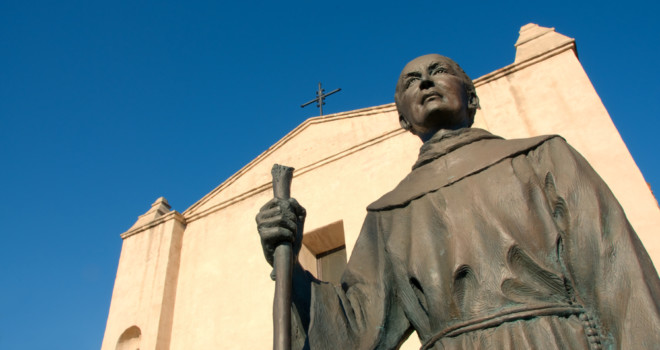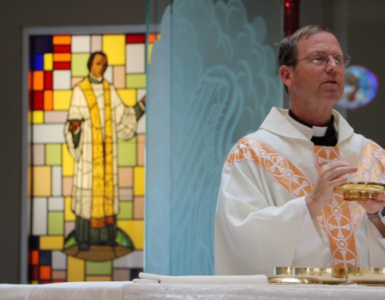July 1st is the feast day of Saint Junípero Serra (1713-1784), the Mallorcan-born, 5’2” Franciscan priest who brought Catholic Christianity to the present-day state of California. It was on this day in 1769 that he entered San Diego and fifteen days later would found a mission, San Diego de Alcalá, the first of nine founded during his tenure. That’s right, he was the ripe old age of 57 when he made it his single-purpose to bring the gospel to the gentiles in what was then referred to as Nueve California.
On January 7, 1780, reflecting on his ministry, Serra wrote to Governor Felipe de Neve: “. . . when we [Fathers] came here, we did not find even a single Christian, that we have engendered them [Indians] all in Christ, that we, everyone of us, came here for the single purpose of doing them good and for their eternal salvation; and I feel sure that everyone knows that we love them.”
Saint Junípero Serra is known today by many monikers — Patron of Vocations, Father of the California Missions, Apostle of California, Evangelizer of the West, a Founding Father of the United States, and the first Hispanic saint of the United States. However, it seems that some historians are politicizing their craft again, with the California missions and its first father-president in their crosshairs. A move is on to dump fourth grade public school children learning early California history by building models of the missions (read here) in the way that generations before them have.
I remember building a model of a mission when I was in the fourth grade in the early 1980s. Being one of seven children, it was memorable for the simple fact that I was getting alone time with my dad. It was not until four years later that I actually visited a mission, Santa Cruz, with a friend and his family. It was when I became a high school teacher in 2000 that I really became interested in California’s mission history. In a few years I drove to all twenty-one missions and fell in love with them. Now I am walking to them. Statistics to date: in 27 days I have covered 446 miles in approximately 168 hours and visited 15 missions of the 21 missions (read my blog here). My relationship with Saint Junípero Serra and those who lived and worked in the missions is deepened with every step. I pray my knowledge and passion is passed onto my son, whose mission project last year was of Misión de San Carlos Borromeo de Carmelo.
The late David J. Weber, professor of history at Southern Methodist University, shed light on the vastness of the Spanish Catholic empire in the Americas in a lecture series that he gave in 2003-2004 at Baylor University. It helps us understand the enterprise Serra was part of. Between 1493 and 1824, 200,000 missionaries toiled in the Americas. By the late 1700s, the time Serra was a missionary, 1/2 of Spain’s claim (twenty-nine times the size of Spain) was controlled by independent Indians.
In 1776, two-hundred-forty settlers traveled from Mexico to colonize San Francisco. Priest, soldier, and colonist were surrounded by an estimated 300,000 Indians. The Spaniard never came into contact with the vast majority of the independent Indians who lived outside the Spanish sphere of influence. In 1790, just over two decades after Serra founded the first mission in present-day California at San Diego, eleven missions and four presidios had been constructed, with an estimated 30 priests and 211 soldiers. A tragic unintended consequence of the cultural exchange was the majority of California Indians who did convert died due to diseases that they had no immunity to.
Due to the geographic isolation and lack of interaction with other peoples, the mission Indian did not fare well during the Spanish era. Father Peyrí, O.F.M. dedicated a memorial in 1830 to the Indian dead at Mission San Luis Rey. The estimated 300,000 Native Californians declined by 33% by the end of the Spanish and Mexican eras. After California statehood, 1850 to as late as 1871, actions supported by the California government fit our modern definition of genocide (as adopted by the United Nations in 1948). By 1870, the number of Native Californians was 30,000 (the state of California has finally gone on record apologizing for its responsibility in genocide). Jonathan Cordero, a sociologist at California Lutheran University, shared in a Catholic News Service article that he estimates that by 1900, there were about 800 mission Indians. Amidst such difficult times, it is a miracle that anything good came from it.
I believe the greatest miracle is Pablo Tac (1822-1841), a Luiseño Indian from Mission San Luis Rey de Francia, located in present-day Oceanside, California. At the age of ten, he left the Mission with Father Peyrí, O.F.M., and another young neophyte boy, Agapito Amamix. Their destination was Rome. On September 23, 1834, Pablo and Agapito enrolled at the Urban College, the first seminarians from the California missions. Pablo’s writings about mission life while a student are the earliest from a California mission Indian. I theorize in my most recent book, Meet Pablo Tac, that Pablo personified what Serra could only dream of, native Catholic leading native Catholic. Pablo was the grandeur of Serra’s legacy. I recently began a petition to nominate Pablo Tac for the cause of canonization.
According to records at The Early California Population Project, Serra’s legacy included 101,000 baptisms, 28,000 marriages and 71,000 burials at all twenty-one missions and from the Los Angeles Plaza Church and the Santa Barbara Presidio. When the first Bishop of Alta California, Francisco Garcia Diego y Moreno, arrived at Santa Barbara on January 11, 1842, there were only seventeen Franciscan priests, mostly aged and infirm, to minister to the people at the twenty-one secularized Indian missions and six Spanish towns.
It was in 1934 that the Very Reverend Novatus Bensing, Provincial of the Franciscan Province of Santa Barbara, proposed that Father Serra be considered for sainthood. In 1943, the Bishop of Monterey-Fresno formed a historical commission to investigate. The court proceedings to question Serra’s worthiness began on December 12, 1948. The evidence brought forth were 2420 documents (7500 pages total) of Serra’s writings, 5000 pages of materials written about him from those who knew him, and testimony of people inspired by his life. A summary of findings would be collected into the Positio (position paper) — Serra’s position was 1,200-pages. It was based on the aforementioned evidence that Pope Francis confidently shared in the homily at Serra’s canonization on September 23, 2015 in Washington, D.C., “Junípero sought to defend the dignity of the native community, to protect it from those who had mistreated and abused it.”
It seems that two camps exist in the mission history war — one calling for drastic change and the other rooted in nostalgia. The extremes of the former camp equate the missions Serra began with Nazi Germany and the concentration camps and slavery in the South and the later camp paint the missions in a pollyannaish way. Both portrayals are asinine! My hope is that professional historians who represent all stakeholders can get together and present the historical truth to our youngsters. Surely Catholics will feel ostracized if this important piece of history is politicized or, even worse, left out (I can only imagine how they felt at the Spring Sing 2019 at Hope School in Santa Barbara. The lyrics for the song “21 California Missions” that the 4th graders sang included, “I’m a dangerous man from the Catholic Church/ So many Indians around us and we’re conquering them all/ Don’t be mad, Build the mission, in the name of religion”.
Luckily, if done well, history can also be a powerful tool to show the common thread that binds us. I believe wholeheartedly that studying any topic from a myriad of viewpoints will make us more thoughtful and understanding. Thoughtfulness and understanding, however, seem in short supply.
In the lead up to Serra’s canonization in September 2015, California state Senator Ricardo Lara proposed removing Serra’s statue from the National Statuary Hall in the US Capitol. Memorials of the 18th-century Franciscan who brought Catholic Christianity to California have been vandalized six times since his canonization—at Monterey, twice in Carmel, in Mission Hills, Old Mission Santa Barbara, and Mission San Gabriel. The front wooden doors and a side wall at Mission Santa Cruz were spray painted in red with the message “Serra St. of Genocide” and another house of worship, Mission Santa Barbara, was vandalized. Stanford University is in the process of ridding its campus of any reference to Serra. On June 21, the University of California at Santa Cruz removed a California mission bell located on campus because a few feel disrespected by its presence.
Saint Junípero Serra, pray for us! May we always exalt the holy cross!
✠













